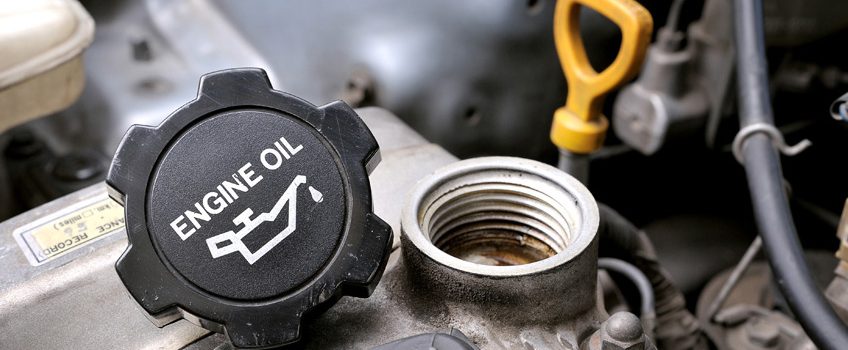How to Change Oil
Difficulty: Easy | More from Team Valvoline: |
Changing your vehicle’s engine oil is not a difficult task, but it is one that must be done properly. Learn how to change oil by following these steps. A correctly performed oil change extends your vehicle’s life while keeping you and the environment safe.
Things you’ll need from your garage or your local NAPA AUTO PARTS Store:
- Oil catch/recycle container
- Funnel
- New NAPA GOLD oil filter
- Oil drain plug gasket
- 4-5 qt. new oil*
- Oil filter wrench set**
- Clean rags
- Car jack
- Jack stands
- Safety glasses
- Mechanics work gloves
- Hand cleaner
*Check your owner’s manual for your vehicle’s oil capacity. Some vehicles take up to 15 quarts!
**If you plan to change your oil regularly, consider investing in a small tool set, an oil filter wrench set, a quality floor jack and jack stands.
Step 1 – Park your car on a level surface and apply parking brake.
Run your engine for 5 minutes before draining oil, as warm oil drains faster than cold. Do NOT drain oil that is at full operating temperature as it will be too hot to safely handle. Remove your keys from the ignition, as some hybrid models can auto-start. To be safe, always check your owner’s manual before working on a specialty vehicle.
Step 2 – Jack your car up and place it on jack stands.
A jack alone will not safely support the full weight of your car. Consult your manual for the proper jacking points. The placement of a jack stand is just as important as the jack placement. The wrong placement can damage your car’s suspension or body parts.
Step 3 – Locate the oil drain plug and place the drain pan below.
The oil drain plug is usually near the front center of the engine, but some vehicles have more than one plug. Check your manual for the exact location. Loosen the plug with a socket or wrench. Make sure that the drain pan is large enough to hold 4-5 quarts of oil or more. The oil drains at an angle, so position the drain pan to catch it.
Step 4 – Unscrew the plug by hand.
Remove the plug by hand. While unscrewing the plug, push it back towards the vehicle. This keeps oil from rushing out until you are ready to remove the plug from the hole.
Step 5 – Drain all oil.
To speed up the draining process, remove the filler cap located on the top of the engine and allow air to enter from the top. Check your owner’s manual for the exact location.
Step 6 – Replace oil plug.
Tighten the oil plug by hand and ensure it is not cross-threaded. Once the plug is snug, finish tightening it with a wrench or by hand. Always use a new drain plug gasket and never over-tighten the drain plug.
Step 7 – Remove existing oil filter.
Place the oil pan underneath the old filter to catch any remaining oil while unscrewing it. Remove the old filter using an oil filter wrench. Use a rag to clean the mounting surface. Make sure that the sealing O-ring from the old filter is not stuck to the mounting surface on the engine. Note: Some vehicles use remote mounted oil filters that may be on top or on the side of the engine.
Step 8 – Lubricate new filter and screw into place by hand.
Lightly coat the rubber seal of the new filter with fresh oil. It’s usually not necessary to tighten the oil filter with the wrench. Refer to the filter’s instructions. Once the filter is installed, lower the car.
Step 9 – Clean the oil filter neck and pour in the new oil using a funnel.
Typically, you will use 4 to 5 quarts of oil, but check your manual for your vehicle’s oil capacity. Fill to three-quarters of the engine’s capacity to avoid overfilling, as there is always oil that does not drain. Then replace the cap.
Step 10 – Run the engine for a few minutes to make sure there are no leaks.
Check the area around the oil drain plug and the filter for any leaks. If you notice a leak, shut the engine off immediately and remedy any leaks. Check the dipstick afterward, and add more oil if necessary.
Step 11 – Dispose of the used oil properly.
Bring your used oil to a recycling center or a NAPA AUTO PARTS store to recycle it for you. These are the only acceptable methods for oil disposal.
IMPORTANT TIPS:
- Read your owner’s manual or see your local NAPA AUTO PARTS store specialists to ensure you are using the correct type of oil and oil filter.
- You’ll need to know the year, make, model and, in some cases, engine type of your car when you buy supplies. If you use our NAPA Know How App, you can scan your VIN so you’ll always have the information you need.
- Make sure your car is securely supported. You will need two jack stands to support the front of your car after jacking it up.
- Record the date and mileage after you change the oil so you will know when your car is due for another oil change. It helps to put a small sticker on your windshield to remind you.
- Handle hot motor oil with extreme caution.
- Use mechanic’s gloves to keep your hands protected and clean.
- Only dispose of used motor oil and filters at authorized locations.
- If you prefer to rely on a professional, your local NAPA AutoCare Center can change your vehicle’s oil for you.


